When choosing a piano, you should:
- Work within your budget
- Understand your free space
- Have realistic expectations of piano performance
- Consider digital features
- Thoroughly research the different piano types
- Try each type before committing
Choosing a piano is a major commitment, and understanding what you should be considering beforehand can prepare you to make this choice. Once you have your needs set in stone, you can proceed with looking at different pianos and testing them out before making any decision.
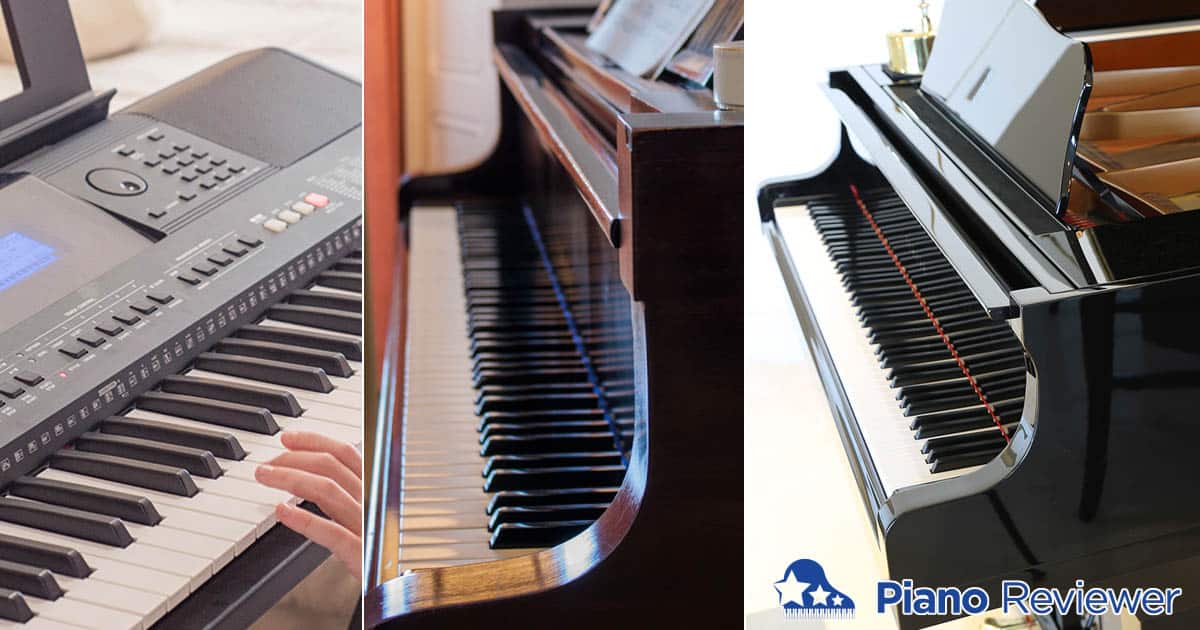
What to Consider Before Choosing a Piano
Choosing a piano to purchase or even rent is not a decision that you should make lightly. Even budget options can be costly, so you need to take the time to ensure you choose a piano that fits your:
- Budget
- Space
- Expectations
You should also take the time to look at your motive and your commitment to the purchase. While pianos are always a worthwhile investment for the willing, without the proper drive, you can be throwing hundreds of dollars into an eventual decorative piece.
As you journey through the process of choosing a piano, you will learn about your preferences and what feels best for you, and you should be able to choose a type of piano to fit your lifestyle.
Budget and Maintenance Costs
Regardless of your budget, there is always an option for you. Prices vary greatly among the different types of keys you can purchase, and you can find options from a couple hundred to tens of thousands of dollars.
If you are unsure of the investment or working on a tight budget, choosing a digital keyboard is a great place to start. These may be more limited than full-sized pianos, but the difference is not enough to hinder your development as a pianist.
Digital pianos are another great budget option, and these digital keys do not require routine maintenance. This means you will only need to pay the initial cost of the digital keyboard or piano, and you do not need to worry about paying for tuning or other mechanical repairs.
The next step on the budgetary ladder is a used acoustic piano. This can run you about $500 to $900 for a decent brand in working condition. You will need to have any used piano inspected by an expert to ensure you are not saddled with repairs immediately upon transfer.
When it comes to acoustic pianos, the price still varies between upright, baby grand, and grand versions. Generally speaking, the larger the piano is, the more expensive it will be.
Acoustic pianos hold their value well, and investing in a high-quality brand like Steinway can pay off in the long run. These pianos require routine maintenance, such as tuning or repairs to the action, and they cost more over time. There are also higher moving costs related to these more intricate instruments.
If purchasing a piano is out of your price range or you are not ready to make that commitment, you can look to rent a piano or a practice room with the type that you want to work with.
Space Limitations and Portability
Space is a major concern with pianos. It is easy to say that you want a grand piano because of its elegant appearance and performance, but one look at the space required might change your mind.
Whichever piano you choose needs to fit in your home without disrupting your daily activities. If it is too large then you can become frustrated with it being in the way. Choosing a piano that is smaller than the free space you have might leave you wanting more from the instrument.
One of the easiest ways to determine the amount of space you need is by outlining the measurements of the piano on the floor using tape. After this is done, go about your day and pretend the piano already occupies that space.
You should quickly learn whether a piano of that size will fit in or become a nuisance.
Pianos should also be as portable as you need. If you do not like being limited to one working space or you need to take the instrument with you, choosing a keyboard would be your best bet. This ensures you are not left without the instrument when you need it.
Performance Expectations
Digital keyboards and pianos have a lot to offer, but they will never be able to replicate the performance of an acoustic piano. You just can not get the same tone and resonance from digital keys, regardless of how much you spend.
Acoustic pianos have a greater dynamic range as well, and it is easier to control dynamics on an acoustic instrument. Players often feel the notes in their fingers and the room, and they might have a deeper emotional connection with pieces.
If you plan on playing many classical pieces or works by 20th-century composers like Debussy, the limited range of a digital keyboard can be a problem.
Digital Features
While digital keyboards and pianos are not the top choices for tone or resonance, they provide plenty of technological features that players may find useful.
You can adjust the volume of digital keyboards and pianos to fit your needs or show mindfulness for neighbors and roommates. Both types of keys can be turned down using a knob, or you can connect headphones for optimal soundproofing.
This also means that these instruments can be connected to amplifiers or speakers to further project the music, making them a popular choice for stage bands.
Digital instruments can also access a wider variety of sounds, and you can switch between pianos, organs, and even non-keyboard instruments like strings. They also have built-in metronomes to assist in keeping time or practice pacing.
Some digital instruments can connect to computers or other devices through a Musical Instrument Digital Interface (MIDI). This is a great way for composers and musicians to record using their keyboard or piano.
Digital devices can also use apps or programs to access more alternative sounds to assign to keys, print out music as it is played, or review work you have done.
Types of Pianos
When choosing a piano, you need to have a good grasp of what your options are. You should not go into a music store and choose the first one that catches your eye.
Instead, look at the pros and cons of each piano type. Pianos fit into 4 specific categories:
- Digital keyboards
- Digital (or electronic) pianos
- Upright pianos
- Grand pianos
Each of these types fits into the budget, space limitations, and performance expectations in different ways.
There is no one-size-fits-all option, so you should have a clear idea of what you need from a piano before trying to make any of these choices fit into your expectations.
Digital Keyboards
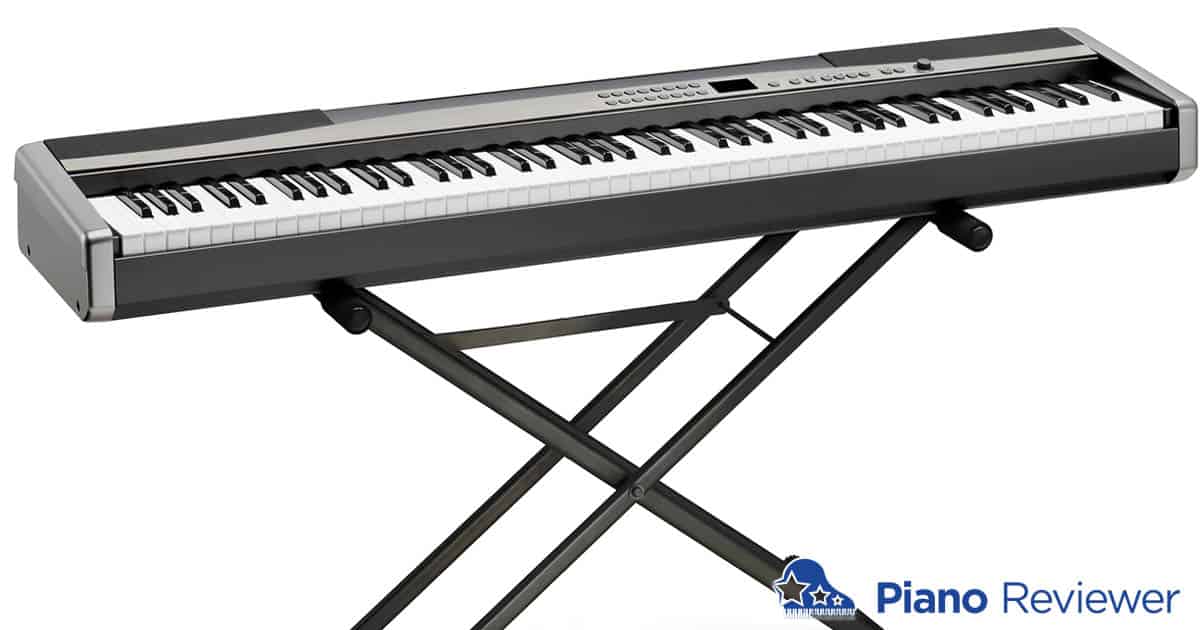
Digital keyboards may be the cheapest option, but they are also the most convenient and versatile. In most cases, a good keyboard can get you pretty far before you start to feel underserved.
Digital keyboards are very light, making them incredibly portable. They are built with a casing around the controls and keys, you can easily pop a keyboard into an appropriate case and take it with you wherever you go.
The sound coming from a keyboard is either synthesized or sampled, so any notes played will have a bit of a replicated feel to them. They are not a one-for-one trade on the feel of an acoustic piano, and you do suffer some losses.
Digital keyboards do not have the same parts as acoustic pianos. Because they lack key action, it can be difficult to achieve appropriate dynamics. Higher quality keyboards attempt to replicate these moving parts by simulating responsiveness, but it makes them heavier and more expensive.
Keyboards also lack a full set of keys. A full-sized piano has 88 keys that cover 7 octaves with 3 extra notes. The next largest piano has 76 keys (6 octaves and 3 extra notes). Most keyboards have less than this. The usual number is 61 keys (5 octaves and 3 extra notes).
While this was the range that composers in Mozart’s time worked with, it can cause issues with some classical pieces and works by 20th-century composers like Debussy.
Digital keyboards do not stand on their own, and you will need to buy a stand so you can maintain proper playing posture. Setting the keyboard on a table often does not lift it high enough, and the table is not a portable option.
You can also purchase a sustain pedal to mimic the ones attached to acoustic pianos. These vary in price depending on quality, ranging from a small, plastic pedal to a metal piano-style lever pedal.
Digital Pianos
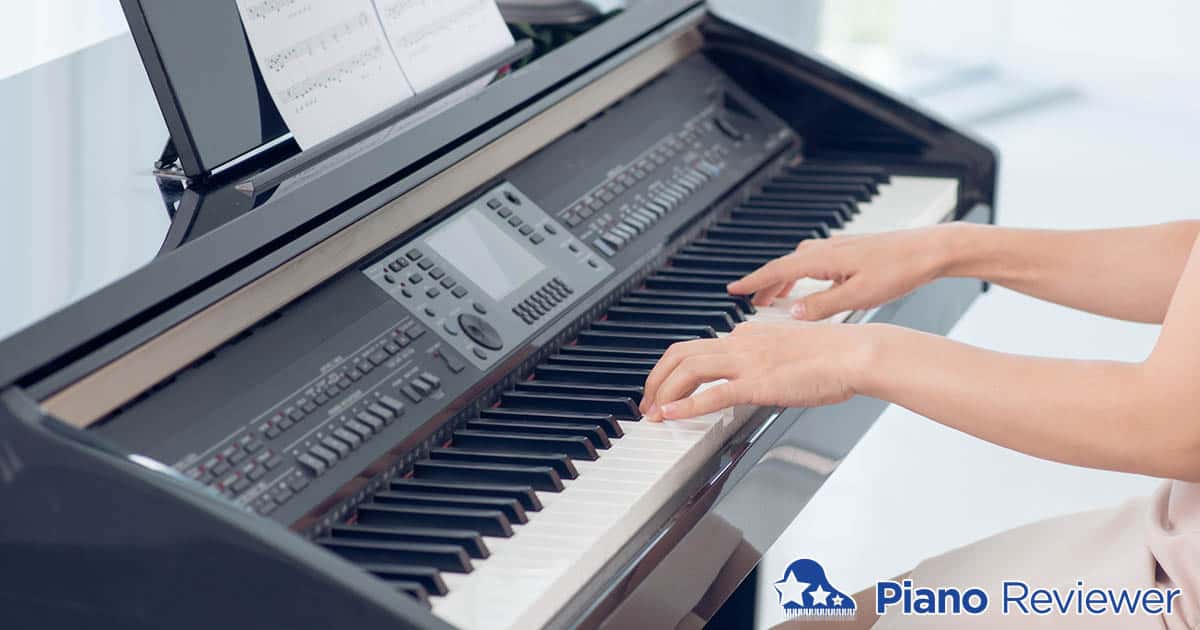
Digital pianos are larger and more expensive than digital keyboards, but they serve as a great mid-tier option. Many choose a digital keyboard because of its versatility and resemblance to the experience of playing an acoustic piano.
Digital pianos usually have hammer action keys, and they are solid instruments made of wood or imitation material. Despite their appearance, they do not require tuning or other regular maintenance like an acoustic piano would.
Like the keyboard, the sounds on a digital piano are synthetic or sampled, and many can play other instrument sounds.
Digital pianos have a full set of 88 keys, so there are no limits in playable pieces.
While they are smaller than acoustic pianos, they are not easy to move around. Digital pianos are still heavy enough to make them stationary pieces.
You should also keep an eye out for any technological advances if you have a digital piano. It is easy for the features on old pianos to become obsolete, and it can be difficult to fight the urge to trade in every time a new feature is released.
Upright Pianos
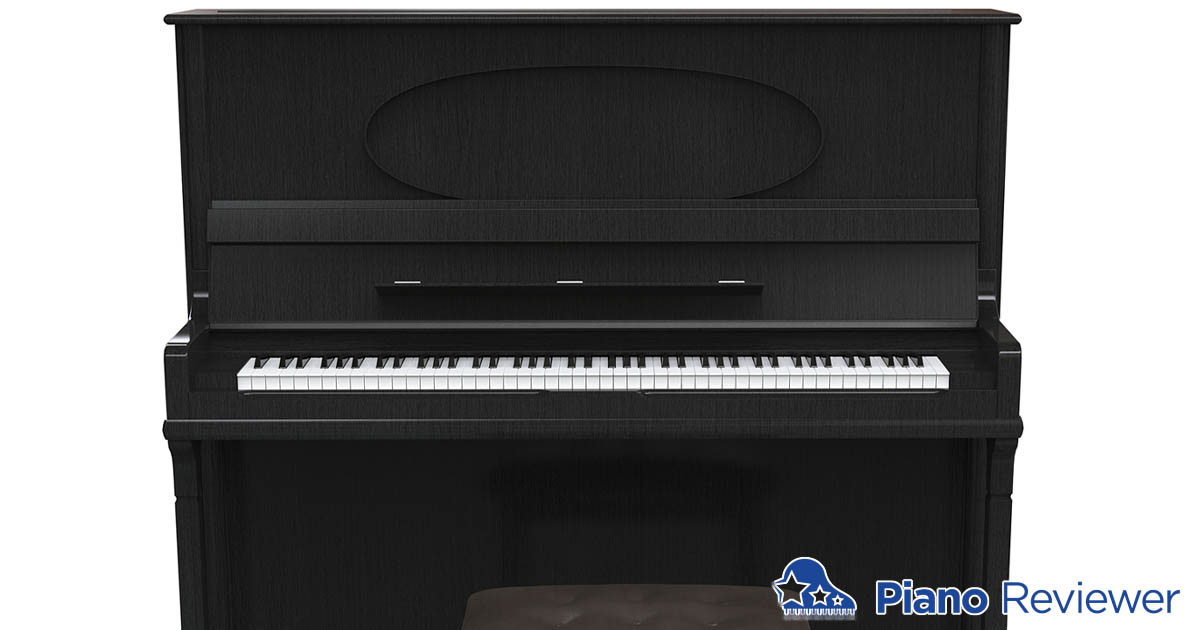
Upright pianos are the smaller of the two acoustic types. These are the pianos that you see in Wild West films or blues band ensembles. They are about 5 feet wide but only 2 feet deep, and they stand anywhere from 37 to 57 inches tall.
Their upright position makes them a great acoustic option for small spaces. Because upright pianos have a flat back, they can be pushed up against a wall and kept out of the way.
The height of an upright piano determines sound quality. Taller pianos have larger soundboards and longer strings, so they are capable of deeper and richer sounds.
Springs are required for the action on upright pianos, reducing the dynamic range and the effortless feel of gliding over the keys.
Grand Pianos
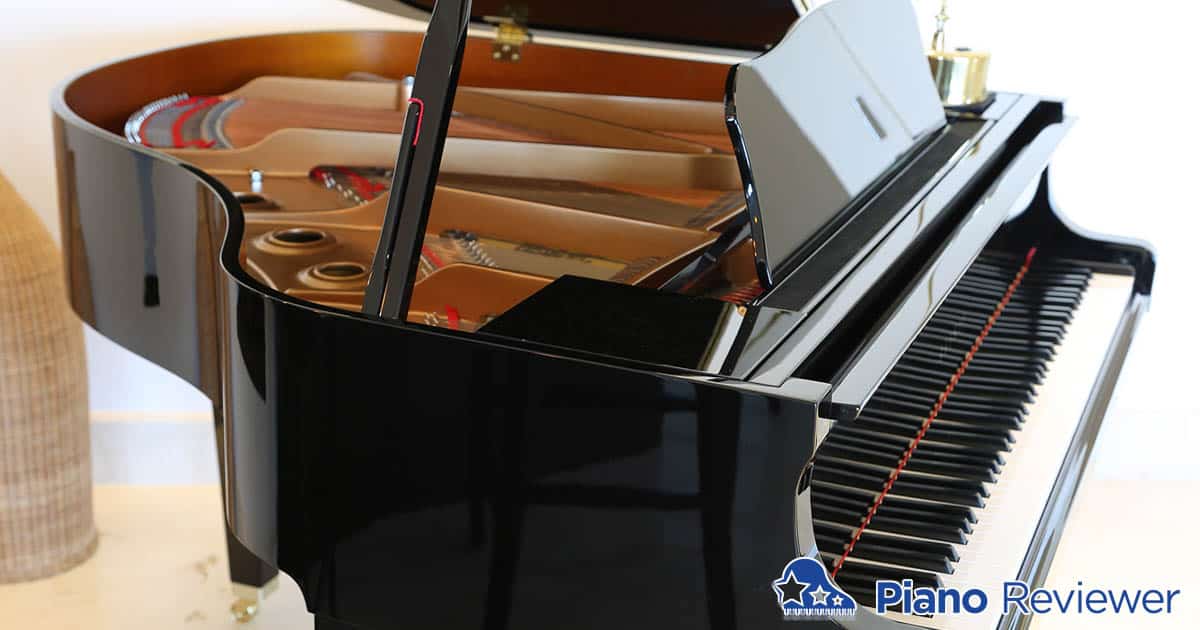
Grand pianos are much larger than any other piano on this list. Even baby grand pianos take up about 5 square feet of floor space. Most grand pianos in the home are 5 or 6 feet from the front to the tail, but concert grands can reach 9 feet.
Grand pianos are trickier to transfer, but movers keep them on their side without their legs and lyre so they can fit through doors easily.
Grand pianos have the best sound quality. Their action is assisted by gravity, making it smooth and quick. This allows for a quicker repetition than most other piano types can handle.
These pianos have the greatest dynamic range, and the tone quality is consistent.
While these were once a sign of wealth and status reserved for royal families in Europe, grand pianos have become moderately affordable over time. As long as space is available, a decent quality used grand can be purchased for a couple thousand dollars
Try Each Piano Type Before Committing
Just because a piano sounds good on paper does not mean that it will fit your needs in practice. Your choice comes down to what fits your needs and feels great under your hands.
Take the time to go in-store and test out the different types of pianos. Even if they do not have the specific model that you are thinking about, getting a feel for the difference between them might change your mind, and you can save yourself time, money, and regret.
Notice the resistance and responsiveness of each type and how well that works for you, and make sure you can explore a greater dynamic range.
Choosing a piano to fit your needs can be a daunting task, but when you list your priorities and do your research you will inevitably find an instrument that helps you bring music to life.
